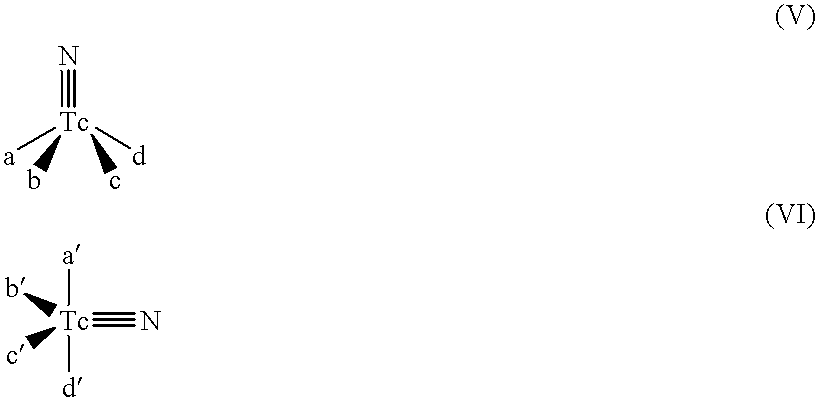Radioactive transition metal nitride heterocomplex
a transition metal and heterocomplex technology, applied in the direction of group 3/13 element organic compounds, group 5/15 element organic compounds, etc., can solve the problems of difficult attachment, no general applicable process has yet been established, and the above-mentioned attachment is difficult to carry out, so as to achieve a more strict control of the exchange reaction
- Summary
- Abstract
- Description
- Claims
- Application Information
AI Technical Summary
Benefits of technology
Problems solved by technology
Method used
Image
Examples
example 1
Reaction for Producing an Intermediate
In a vial containing 5 mg of succinic acid dihydrazide (hereinafter abbreviated as SDH) were placed a solution obtained by dissolving 1.5 mg of bis(diphenylphosphinoethyl)ethylamine (PNP) in a mixture of 0.6 ml of ethanol and 0.1 ml (1.0 mol / l) of an aqueous hydrochloric acid solution, and then a physiologically acceptable .sup.99m TcO.sub.4.sup.- solution (0.5 ml, 50 MBq).
The resulting mixture was heated at 80.degree. C. for 20 minutes. The intermediate complex thus obtained was analyzed by high performance thin layer chromatography (HTLC) and high performance liquid chromatography (HPLC). FIG. 1 and FIG. 2 show radiochromatograms of the complex each of which was obtained by development on a silica gel plate with an ethanol / chloroform / benzene (0.85 / 2 / 1.5) mixture. Three peaks appeared in the chromatogram obtained under acidic conditions, indicating that three products were obtained (FIG. 1). On the other hand, when the pH was adjusted to about ...
example 2
Reaction of 1-thio-.beta.-D-glucose (.beta.-glu) with the Intermediate
In a mixture of 0.6 ml of ethanol and 0.1 ml (1 mol / l) of an aqueous HCl solution were dissolved 5 mg of SDH and 1.5 mg of PNP, followed by adding thereto a physiologically acceptable .sup.99m TcO.sub.4.sup.- solution (0.5 ml, 50 MBq). The resulting mixture was heated at 80.degree. C. for 20 minutes and then cooled to 40.degree. C., after which 0.25 ml of HCO.sub.3.sup.- / CO.sub.3.sup.2- buffer was added thereto to adjust the pH at about 8.0. Subsequently, a solution of 0.5 mg of .beta.-glu in 1.5 ml of water was added. The complex finally obtained was analyzed by HTLC and HPLC. FIG. 3 shows a radiochromatogram of the complex which was obtained by development on a silica gel plate with tetrahydrofuran. The radiochemical purity of the final complex was higher than 95%. The complex contained a Tc.ident.N group in which a PNP bidentate ligand was coordinated with the metal ion at trans conformation and .beta.-glu, i....
example 3
Reaction of Thiosalicylic Acid (tsa) with the Intermediate
In a mixture of 0.6 ml of ethanol and 0.1 ml (1 mol / l) of an aqueous HCl solution were dissolved 5 mg of SDH and 1.5 mg of PNP, followed by adding thereto a physiologically acceptable .sup.99m TcO.sub.4.sup.- solution (0.5 ml, 50 MBq). The resulting mixture was heated at 80.degree. C. for 20 minutes and then cooled to room temperature, after which 1 ml of sodium phosphate buffer (0.05 mol / l) was added thereto to adjust the pH to about 7.8. Subsequently, a solution of 5.0 mg of tsa in 0.20 ml of ethanol was added, and the resulting mixture was allowed to stand at room temperature for 5 minutes. The complex finally obtained was analyzed by HTLC and HPLC. FIG. 4 shows a radiochromatogram of the complex which was obtained by development on a silica gel plate with an ethanol / chloroform / benzene (0.7 / 2 / 1.5) mixture. The radiochemical purity of the final complex was higher than 95%. The complex contained a Tc.ident.N group in which a...
PUM
| Property | Measurement | Unit |
|---|---|---|
| temperature | aaaaa | aaaaa |
| temperature | aaaaa | aaaaa |
| temperature | aaaaa | aaaaa |
Abstract
Description
Claims
Application Information
 Login to View More
Login to View More - R&D
- Intellectual Property
- Life Sciences
- Materials
- Tech Scout
- Unparalleled Data Quality
- Higher Quality Content
- 60% Fewer Hallucinations
Browse by: Latest US Patents, China's latest patents, Technical Efficacy Thesaurus, Application Domain, Technology Topic, Popular Technical Reports.
© 2025 PatSnap. All rights reserved.Legal|Privacy policy|Modern Slavery Act Transparency Statement|Sitemap|About US| Contact US: help@patsnap.com



